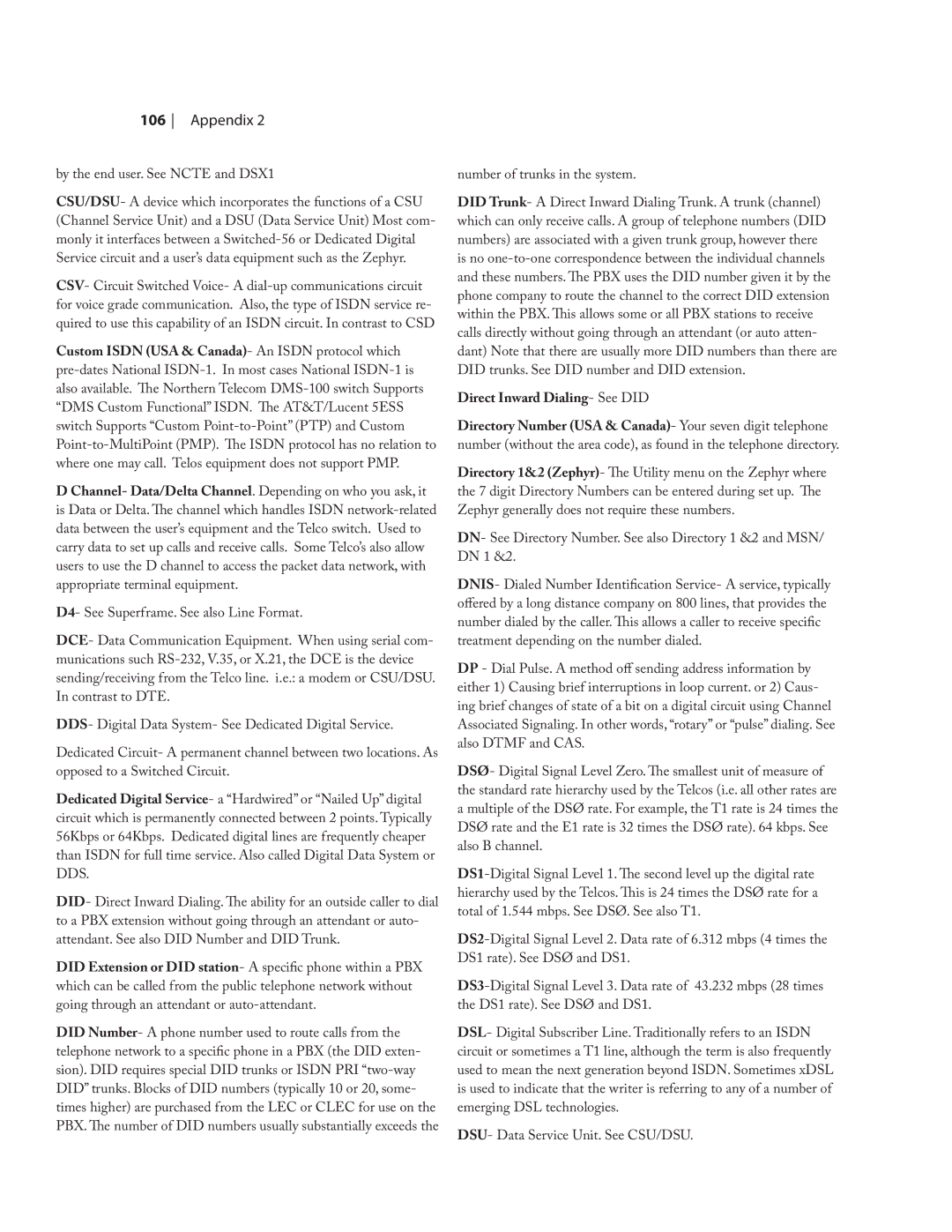106 Appendix 2
by the end user. See NCTE and DSX1
CSU/DSU- A device which incorporates the functions of a CSU (Channel Service Unit) and a DSU (Data Service Unit) Most com- monly it interfaces between a
CSV- Circuit Switched Voice- A
Custom ISDN (USA & Canada)- An ISDN protocol which
D Channel- Data/Delta Channel. Depending on who you ask, it is Data or Delta. The channel which handles ISDN
D4- See Superframe. See also Line Format.
DCE- Data Communication Equipment. When using serial com- munications such
DDS- Digital Data System- See Dedicated Digital Service.
Dedicated Circuit- A permanent channel between two locations. As opposed to a Switched Circuit.
Dedicated Digital Service- a “Hardwired” or “Nailed Up” digital circuit which is permanently connected between 2 points. Typically 56Kbps or 64Kbps. Dedicated digital lines are frequently cheaper than ISDN for full time service. Also called Digital Data System or DDS.
DID- Direct Inward Dialing. The ability for an outside caller to dial to a PBX extension without going through an attendant or auto- attendant. See also DID Number and DID Trunk.
DID Extension or DID station- A specific phone within a PBX which can be called from the public telephone network without going through an attendant or
DID Number- A phone number used to route calls from the telephone network to a specific phone in a PBX (the DID exten- sion). DID requires special DID trunks or ISDN PRI
number of trunks in the system.
DID Trunk- A Direct Inward Dialing Trunk. A trunk (channel) which can only receive calls. A group of telephone numbers (DID numbers) are associated with a given trunk group, however there is no
Direct Inward Dialing- See DID
Directory Number (USA & Canada)- Your seven digit telephone number (without the area code), as found in the telephone directory.
Directory 1&2 (Zephyr)- The Utility menu on the Zephyr where the 7 digit Directory Numbers can be entered during set up. The Zephyr generally does not require these numbers.
DN- See Directory Number. See also Directory 1 &2 and MSN/ DN 1 &2.
DNIS- Dialed Number Identification Service- A service, typically offered by a long distance company on 800 lines, that provides the number dialed by the caller. This allows a caller to receive specific treatment depending on the number dialed.
DP - Dial Pulse. A method off sending address information by either 1) Causing brief interruptions in loop current. or 2) Caus- ing brief changes of state of a bit on a digital circuit using Channel Associated Signaling. In other words, “rotary” or “pulse” dialing. See also DTMF and CAS.
DSØ- Digital Signal Level Zero. The smallest unit of measure of the standard rate hierarchy used by the Telcos (i.e. all other rates are a multiple of the DSØ rate. For example, the T1 rate is 24 times the DSØ rate and the E1 rate is 32 times the DSØ rate). 64 kbps. See also B channel.
DSL- Digital Subscriber Line. Traditionally refers to an ISDN circuit or sometimes a T1 line, although the term is also frequently used to mean the next generation beyond ISDN. Sometimes xDSL is used to indicate that the writer is referring to any of a number of emerging DSL technologies.
DSU- Data Service Unit. See CSU/DSU.
